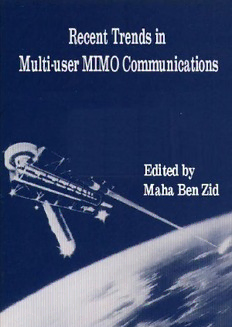Table Of ContentRecent Trends
Multi-user MIMO Communications
Edited by
Recent Trends in Multi-user MIMO Communications
Edited by Maha Ben Zid
D3pZ4i & bhgvld, Dennixxx & rosea (for softarchive)
Stole src from http://avaxho.me/blogs/exLib/
Published by AvE4EvA
Copyright © 2013
All chapters are Open Access distributed under the Creative Commons Attribution 3.0
license, which allows users to download, copy and build upon published articles even for
commercial purposes, as long as the author and publisher are properly credited, which
ensures maximum dissemination and a wider impact of our publications. After this work
has been published by InTech, authors have the right to republish it, in whole or part, in
any publication of which they are the author, and to make other personal use of the
work. Any republication, referencing or personal use of the work must explicitly identify
the original source.
As for readers, this license allows users to download, copy and build upon published
chapters even for commercial purposes, as long as the author and publisher are properly
credited, which ensures maximum dissemination and a wider impact of our publications.
Notice
Statements and opinions expressed in the chapters are these of the individual contributors
and not necessarily those of the editors or publisher. No responsibility is accepted for the
accuracy of information contained in the published chapters. The publisher assumes no
responsibility for any damage or injury to persons or property arising out of the use of any
materials, instructions, methods or ideas contained in the book.
Publishing Process Manager
Technical Editor AvE4EvA MuViMix Records
Cover Designer
December 04, 2013
ISBN 978-953-51-1210-5
Contents
Preface
1 Multi User MIMO Communication: Basic Aspects, Benefits and Challenges
by Ben Zid Maha and Raoof Kosai
2 Random Beamforming in Multi – User MIMO Systems
by Hieu Duy Nguyen, Rui Zhang and Hon Tat Hui
3 Multi-user MIMO in LTE and LTE-Advanced - Receiver Structure and
Precoding Design
y Rizwan Ghaffar, Raymond Knopp and Florian Kaltenberger
4 Multi-User Interference Suppression by Using Frequency Domain
Adaptive Antenna Array
by Wei Peng an d Fumiyuki Adachi
5 Multiuser MAC Schemes for High-Throughput IEEE 802.11n/ac WLANs
by Elli Kartsakli, Nizar Zorba, Luis Alonso and Christos Verikoukis
6 Physical Layer Security for Multiuser MIMO Communications
by Giovanni Ge raci and Jinhong Yuan
7 Lattice Reduction-Based User Selec tion in Multiuser MIMO Systems
by Qiaoyu Li, Ying Li, Lin Bai and Jinho Choi
Preface
This book emphasis on multi-user MIMO communication.
It covers a collection of the major topics and issues
in multi-user MIMO systems.
Recent Trends in Multi-user MIMO Communications provides
a tutorial overview of the latest technologies and
research keys related to multi-user communication.
This book is composed of seven chapters, each written
by a different set of authors. Features include:
Fundamentals of multi-user MIMO communication,
Random Beamforming in multi-user MIMO systems,
LTE and LTE-Advanced framework,
Interference cancellation in multi-user MIMO systems,
Incorporation of multi-user capabilities in
IEEE 802.11n/ac for WLAN systems,
Physical layer security for multi-user MIMO communication,
User selection based error probability of MIMO detector
in multi-user MIMO systems.
Provisionalchapter
Chapter 1
Multi User MIMO Communication: Basic Aspects,
Multi User MIMO Communication: Basic Aspects,
Benefits and Challenges
Benefits and Challenges
BenZidMaha,RaoofKosai
Ben Zid Maha and Raoof Kosai
AAddddiittioionnaalli ninfoformrmataiotinoins iasv aavilaabilalebalet tahte thened enofdt ohef tchhea pcthearpter
http://dx.doi.org/10.5772/57133
10.5772/57133
1.Introduction
The explosive growth of Multiple Input Multiple Output (MIMO) systems has permitted
for high data rate and a wide variety of applications. Some of the technologies which rely
on these systems are IEEE 802.11, Third Generation (3G) and Long Term Evolution (LTE)
ones. Recentadvancesinwirelesscommunicationsystemshavecontributedtothedesignof
multi-userscenarioswithMIMOcommunication. Thesecommunicationsystemsarereferred
as multi-user MIMOs. Such systems are intended for the development of new generations
of wireless mobile radio systems for future cellular radio standards. This chapter provides
aninsightintomulti-userMIMOsystems. Wefirstlypresentsomeofthemainaspectsofthe
MIMO communication. We introduce the basic concepts of MIMO communication as well
asMIMOchannelmodeling. Thereafter,weevaluatetheMIMOsystemperformances. Then,
we concentrate our analysis on the multi-user MIMO systems and we provide the reader a
conceptual understanding with the multi-user MIMO technology. To do so, we present the
communication system model for such emerging technology and we give some examples
which describe the recent advances for multi-user MIMO systems. Finally, we introduce
linearprecodingtechniqueswhichcouldbeexploitedinmulti-userMIMOsystemsinorder
tosuppressinter-userinterference.
2.MIMO communication
2.1.Anhistoricaloverview
ThemainhistoricaleventswhichmaketheMIMOsystems[2][3]aresummarizedasfollows:
• In 1984, Jack Winters at Bell Laboratories wrote a patent on wireless communications
usingmultipleantennas. JackWintersin[4]presentedastudyofthefundamentallimits
onthedatarateofmultipleantennasystemsinaRayleighfadingenvironment.
4 Recent Trends in Multi-user MIMO Communications
2 RecentTrendsinMultiuserMIMOCommunications
• In 1993, Arogyaswami Paulraj and Thomas Kailath proposed the concept of spatial
multiplexingusingMIMO.
• SeveralarticleswhichfocusedonMIMOconceptwerepublishedintheperiodfrom1986
to 1995[5]. Thiswas followedby thework ofGreg Raleighand GerardJoseph Foschini
in 1996 which invented new approaches involving space time coding techniques. These
approacheswereprovedtoincreasethespectralefficiencyofMIMOsystems.
• In 1999, Thomas L. Marzetta and Bertrand M. Hochwald published an article [6] which
provides a rigorous study on the MIMO Rayleigh fading link taking into consideration
informationtheoryaspects.
• ThefirstcommercialMIMOsystemwasdevelopedin2001byIospanWirelessInc.
• Since 2006, several companies such as Broadcom and Intel have introduced a novel
communicationtechniquebasedontheMIMOtechnologyforimprovingtheperformance
of wireless Local Area Network (LAN) systems. The new standard of wireless LAN
systemsisnamedIEEE802.11n.
Nowadays,MIMOsystemsareimplementedinmanyadvancedtechnologiessuchasvarious
standard proposals forthe Fourth Generation (4G)of wireless communication systemsand
LTE. MIMO technology was shown to boost the communication system capacity and to
enhance the reliability of the communication link since it uses several diversity schemes
beyondthespatialdiversity.
2.2.FundamentalsofMIMOsystem
MIMOsystemmodelisdepictedinFigure1. Wepresentacommunicationsystemwith N
T
transmitantennasand N receiveantennas.
R
Transmitter Receiver
Tx1 ✩ ✬Rx1
x ✲ y
✯
x1 ✼ y1
✎ ☞ ✎ ☞
Tx2 Rx2
✲❥
x2 ❃ y2
... ... ... ...
TxNT RxNR
✇
s
✲
xNT yNR
H(NR×NT)
✍ ✌ ✍ ✌
Figure1.MIMOsystemmodel ✪ ✫

